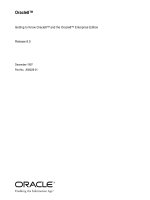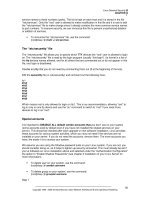Upgrading and repairing PCs 21st edition
Bạn đang xem bản rút gọn của tài liệu. Xem và tải ngay bản đầy đủ của tài liệu tại đây (41.05 MB, 1,285 trang )
Upgrading and Repairing PCs
21st Edition
Scott Mueller
800 East 96th Street, Indianapolis, Indiana 46240
Upgrading and Repairing PCs, 21st Edition
Copyright © 2013 by Pearson Education, Inc.
All rights reserved. No part of this book shall be reproduced, stored in a retrieval system, or
transmitted by any means, electronic, mechanical, photocopying, recording, or otherwise, without
written permission from the publisher. No patent liability is assumed with respect to the use of the
information contained herein. Although every precaution has been taken in the preparation of this
book, the publisher and author assume no responsibility for errors or omissions. Nor is any liability
assumed for damages resulting from the use of the information contained herein.
ISBN-13: 978-0-7897-5000-6
ISBN-10: 0-7897-5000-7
Library of Congress Cataloging-in-Publication Data in on file.
Printed in the United States of America
Second Printing: July 2013
Editor-in-Chief
Greg Wiegand
Acquisitions Editor
Rick Kughen
Development Editor
Todd Brakke
Managing Editor
Sandra Schroeder
Project Editor
Mandie Frank
Copy Editor
Sheri Cain
Indexer
Erika Millen
Proofreader
Gill Editorial Services
Technical Editor
Chris Crayton
Editorial Assistant
Cindy Teeters
Media Producer
Dan Scherf
Designer
Anne Jones
Compositor
Bronkella Publishing
Trademarks
All terms mentioned in this book that are known to be trademarks or service marks have been
appropriately capitalized. Que Publishing cannot attest to the accuracy of this information. Use of a
term in this book should not be regarded as affecting the validity of any trademark or service mark.
Warning and Disclaimer
Every effort has been made to make this book as complete and as accurate as possible, but no
warranty or fitness is implied. The information provided is on an “as is” basis. The author and the
publisher shall have neither liability nor responsibility to any person or entity with respect to any loss
or damages arising from the information contained in this book or from the use of the DVD or
programs accompanying it.
Bulk Sales
Que Publishing offers excellent discounts on this book when ordered in quantity for bulk purchases or
special sales. For more information, please contact
U.S. Corporate and Government Sales
1-800-382-3419
For sales outside of the U.S., please contact
International Sales
Contents at a Glance
Introduction
1 Development of the PC
2 PC Components, Features, and System Design
3 Processor Types and Specifications
4 Motherboards and Buses
5 BIOS
6 Memory
7 The ATA/IDE Interface
8 Magnetic Storage Principles
9 Hard Disk Storage
10 Flash and Removable Storage
11 Optical Storage
12 Video Hardware
13 Audio Hardware
14 External I/O Interfaces
15 Input Devices
16 Internet Connectivity
17 Local Area Networking
18 Power Supplies
19 Building or Upgrading Systems
20 PC Diagnostics, Testing, and Maintenance
Index
Accessing the Media Included with this Book
Contents
Introduction
1 Development of the PC
Computer History: Before Personal Computers
Timeline
Electronic Computers
Modern Computers
From Tubes to Transistors
Integrated Circuits
History of the PC
Birth of the Personal Computer
The IBM Personal Computer
The PC Industry 30 Years Later
2 PC Components, Features, and System Design
What Is a PC?
Who Controls PC Software?
Who Controls PC Hardware?
White-Box Systems
System Types
System Components
3 Processor Types and Specifications
Microprocessor History
The First Microprocessor
PC Processor Evolution
16-Bit to 64-Bit Architecture Evolution
Processor Specifications
Data I/O Bus
Address Bus
Internal Registers (Internal Data Bus)
Processor Modes
Processor Benchmarks
Comparing Processor Performance
Cache Memory
Processor Features
System Management Mode (SMM)
Superscalar Execution
MMX Technology
Dynamic Execution
Dual Independent Bus Architecture
HT Technology
Multicore Technology
Hardware-Assisted Virtualization Support
Processor Manufacturing
Processor Re-Marking
PGA Chip Packaging
Single Edge Contact and Single Edge Processor Packaging
Processor Socket and Slot Types
Socket 478
Socket LGA775
Socket LGA1156
Socket LGA1366
Socket LGA1155
Socket LGA2011
Socket 939 and 940
Socket AM2/AM2+/AM3/AM3+
Socket F (1207FX)
Socket FM1
Socket FM2
CPU Operating Voltages
Math Coprocessors (Floating-Point Units)
Processor Bugs and Steppings
Processor Code Names
P1 (086) Processors
P2 (286) Processors
P3 (386) Processors
P4 (486) Processors
P5 (586) Processors
AMD-K5
Intel P6 (686) Processors
Pentium Pro Processors
Pentium II Processors
Pentium III
Celeron
Intel Pentium 4 Processors
Pentium 4 Extreme Edition
Intel Pentium D and Pentium Extreme Edition
Intel Core Processors
Intel Core 2 Family
Intel (Nehalem) Core i Processors
AMD K6 Processors
NexGen Nx586
AMD-K6 Series
AMD K7 Processors
AMD Athlon
AMD Duron
AMD Athlon XP
Athlon MP
AMD K8 Processors
AMD Athlon 64 and 64 FX
AMD Sempron
AMD Athlon X2, 64 X2, and 64 FX
AMD K10 Processors (Phenom, Phenom II, Athlon II, Athlon X2, Sempron)
AMD “Bulldozer” and “Piledriver” FX Processors
AMD Fusion/HSA (Heterogeneous Systems Architecture) APUs
Processor Upgrades
Overclocking
Quartz Crystals
Modern PC Clocks
Overclocking Tips
Unlocking Cores
Bus Speeds and Multipliers
Processor Cooling
Heatsinks
Liquid Cooling
Thermally Advantaged Chassis
Processor Troubleshooting Techniques
4 Motherboards and Buses
Motherboard Form Factors
Obsolete Form Factors
ATX and Other Modern Form Factors
Processor Sockets/Slots
Chipsets
Chipset Evolution
Intel Chipsets
Intel Chipset Model Numbers
Intel Integrated Graphics Architecture
AMD Integrated Graphics Architecture
Traditional North/South Bridge Architecture
Hub Architecture
HyperTransport and Other Processor/Chipset Interconnects
Intel’s Early 386/486 Chipsets
Fifth-Generation (P5 Pentium Class) Chipsets
Sixth-Generation (P6 Pentium Pro/II/III Class) Chipsets
Seventh/Eighth-Generation (Pentium 4/D, Core 2, and Core i) Chipsets
Intel 915 Family
Intel 925X Family
Intel 945 Express Family
Intel 955X and 975X Family
Intel 96x Series
Intel 3x and 4x Series Chipsets
Intel 5x Series Chipsets
Intel 6x Series Chipsets
Intel 7x Series Chipsets
Third-Party Chipsets for Intel Processors
SiS Chipsets
ULi Electronics Chipsets
ATI Chipsets
VIA Chipsets
NVIDIA Chipsets for Intel Processors
Chipsets for AMD Processors
AMD Athlon Chipsets
AMD Athlon 64 Chipsets
AMD 8000 (8151) Chipset
AMD (Formerly ATI) Chipsets for Athlon 64, Sempron, Phenom
Third-Party Chipsets for AMD Processors
VIA Chipsets
SiS Chipsets
NVIDIA Chipsets
Super I/O Chips
Motherboard Connectors
System Bus Types, Functions, and Features
The Processor Bus (FSB)
Types of I/O Buses
The ISA Bus
The Micro Channel Bus
The EISA Bus
Local Buses (VESA, PCI, PCI Express, AGP)
System Resources
Interrupts
DMA Channels
I/O Port Addresses
Motherboard Selection Criteria (Knowing What to Look For)
Chipset Documentation
5 BIOS
BIOS Basics
Motherboard ROM BIOS
ROM Hardware
ROM Shadowing
ROM Chip Types
ROM BIOS Manufacturers
BIOS Hardware/Software
Upgrading the BIOS
Where to Get Your BIOS Update
Determining Your BIOS Version
Checking the BIOS Date
Backing Up Your BIOS
Backing Up Your BIOS Setup (CMOS RAM) Settings
Upgrading a Flash BIOS
Motherboard CMOS RAM Addresses
Preboot Environment
Unified Extensible Firmware Interface (UEFI)
UEFI and BIOS Limitations
UEFI Support
BIOS Setup
Running or Accessing the BIOS Setup Program
BIOS Setup Menus
Maintenance Menu
Main Menu
Advanced Menus
Security Menu
Power Menu
Boot Menu (Boot Sequence, Order)
Exit Menu
Additional BIOS Setup Features
PnP BIOS
PnP Device IDs
ACPI
BIOS/MBR Error Messages
BIOS Boot Error Messages
MBR Boot Error Messages
6 Memory
Memory Basics
ROM
DRAM
Cache Memory: SRAM
Memory Standards
Speed and Performance
Fast Page Mode DRAM
Extended Data Out RAM
SDRAM
DDR SDRAM
DDR2 SDRAM
DDR3 SDRAM
DDR4 SDRAM
RDRAM
Memory Modules
Registered Modules
SDR DIMM Details
DDR DIMM Details
DDR2 DIMM Details
DDR3 DIMM Details
Determining a Memory Module’s Size and Features
Memory Banks
Memory Module Speed
Parity and ECC
Parity Checking
How Parity Checking Works
ECC
RAM Upgrades
Upgrade Options and Strategies
Purchasing Memory
Replacing Modules with Higher-Capacity Versions
Installing Memory Modules
Troubleshooting Memory
Memory Defect Isolation Procedures
The System Logical Memory Layout
7 The ATA/IDE Interface
An Overview of the IDE Interface
Precursors to IDE
IDE Origins
Origins of ATA
ATA Standards
ATA-1 (ATA Interface for Disk Drives)
ATA-2 (ATA Interface with Extensions-2)
ATA-3 (ATA Interface-3)
ATA/ATAPI-4 (ATA with Packet Interface Extension-4)
ATA/ATAPI-5 (ATA with Packet Interface-5)
ATA/ATAPI-6 (ATA with Packet Interface-6)
ATA/ATAPI-7 (ATA with Packet Interface-7)
ATA/ATAPI-8
PATA
PATA I/O Connector
PATA I/O Cable
Longer or Rounded Cables
PATA Signals
PATA Dual-Drive Configurations
PATA PIO Transfer Modes
PATA DMA Transfer Modes
SATA
SATA Standards and Performance
SATA Express
SATA Cables and Connectors
eSATA
SATA Configuration
Advanced Host Controller Interface (AHCI)
Non-Volatile Memory Express (NVMe)
SATA Transfer Modes
ATA Features
ATA Commands
ATA Security Mode
Host Protected Area
ATAPI
ATA Drive Capacity Limitations
Prefixes for Decimal and Binary Multiples
BIOS Limitations
CHS Versus LBA
CHS/LBA and LBA/CHS Conversions
BIOS Commands Versus ATA Commands
CHS Limitations (the 528MB Barrier)
CHS Translation (Breaking the 528MB Barrier)
The 2.1GB and 4.2GB Barriers
LBA-Assist Translation
The 8.4GB Barrier
The 137GB Barrier and Beyond
Operating System and Other Software Limitations
GPT and the 2.2TB Barrier
PATA/SATA RAID
Software RAID
8 Magnetic Storage Principles
Magnetic Storage
History of Magnetic Storage
How Magnetic Fields Are Used to Store Data
Read/Write Head Designs
Ferrite
Metal-In-Gap
Thin-Film
Magneto-Resistive Heads
Giant Magneto-Resistive Heads
Head Sliders
Data-Encoding Schemes
Frequency Modulation Encoding
Modified FM Encoding
Run Length Limited Encoding
Encoding Scheme Comparisons
Partial-Response, Maximum-Likelihood Decoders
Capacity Measurements
Areal Density
Perpendicular Magnetic Recording
9 Hard Disk Storage
Definition of a Hard Disk
Hard Drive Advancements
Form Factors
5 1/4-Inch Drive
3 1/2-Inch Drive
2 1/2-Inch Drive
1.8-Inch Drive
1-Inch Drives
HDD Operation
The Ultimate HDD Analogy
Tracks and Sectors
ECC
Disk Formatting
Basic HDD Components
Hard Disk Platters (Disks)
Recording Media
Read/Write Heads
Head Actuator Mechanisms
Air Filters
Hard Disk Temperature Acclimation
Spindle Motors
Logic Boards
Cables and Connectors
Configuration Items
Hard Disk Features
Capacity
Performance
Reliability
10 Flash and Removable Storage
Alternative Storage Devices
Flash Memory Devices
CompactFlash
SmartMedia
MultiMediaCard
SecureDigital
Sony Memory Stick
ATA Flash PC Card
xD-Picture Card
SSD (Solid-State Drive)
USB Flash Drives
Comparing Flash Memory Devices
SD Cards Speed Class and UHS Speed Class Markings
File Systems Used by Flash Memory
Flash Card Readers
Card Readers
ReadyBoost Support
Cloud-Based Storage
Floppy Disk Drives
Tape Drives
11 Optical Storage
Optical Technology
CD-Based Optical Technology
CDs: A Brief History
CD Construction and Technology
Mass-Producing CDs
Writable CDs
MultiRead Specifications
MultiPlay and MultiAudio
DVD
DVD History
DVD Construction and Technology
DVD Tracks and Sectors
Handling DVD Errors
DVD Capacity (Sides and Layers)
Data Encoding on the DVD Disc
Recordable DVD Standards
Multiformat Rewritable DVD Drives
BD
HD-DVD
Optical Disc Formats
CD Formats
DVD Formats and Standards
Optical Disc File Systems
Ripping/Copying Discs
“For Music Use Only” CD-R/RW Discs
CD Copy Protection
CD Digital Rights Management
DVD and Blu-ray Copy Protection
Optical Drive Performance Specifications
CD Data Transfer Rate
CD Drive Speed
DVD Drive Speed
Access Time
Buffer/Cache
Direct Memory Access and Ultra-DMA
Interface
Loading Mechanism
Other Drive Features
How to Reliably Record Optical Discs
Booting from a Floppy Disk with Optical Drive Support
Bootable Optical Discs—El Torito
LightScribe and LabelFlash
Troubleshooting Optical Drives
Caring for Optical Media
Updating the Firmware in an Optical Drive
12 Video Hardware
Display Adapters and Monitors
Video Display Adapters
Video Adapter Types
Integrated Video/Motherboard Chipsets
CPUs with Integrated Video
Video Adapter Components
Identifying the Video and System Chipsets
Video RAM
The DAC
Video Display Interfaces
The System Interface
The Display Interface
TV Display Interfaces
3D Graphics Accelerators
How 3D Accelerators Work
APIs
Dual-GPU Scene Rendering
Monitors
Display Specifications
LCD Technology
LED Backlit Technology
CRT Display Technology
Plasma Display Technology
LCD and DLP Projectors
Using Multiple Monitors
Dualview
Homogeneous Adapters
Heterogeneous Adapters
Choosing the Best Display Hardware for a Particular Task
Video Troubleshooting and Maintenance
Troubleshooting Video Cards and Drivers
Video Drivers
Maintaining Monitors
Testing Monitors
Adjusting Monitors
Bad Pixels
Troubleshooting Monitors
Repairing Monitors
13 Audio Hardware
Audio Hardware Concepts and Terms
The Nature of Sound
Evaluating the Quality of Your Audio Hardware
Sampling
Early PC Sound Cards
Limitations of Sound Blaster Pro Compatibility
Microsoft Windows and Audio Support
DirectX and Audio Support Hardware
Core Audio APIs for Windows
3D Gaming Audio Standards
Legacy Audio Support Through Virtualization
Audio Hardware Features
Basic Connectors
Audio Signal Processing Methods
Advanced Audio Features
Volume Control
MIDI Support Features
Data Compression
Sound Drivers
Sound Cards for Sound Producers
Motherboard Chipsets with Integrated Audio
Intel “Azalia” HD Audio
Troubleshooting PC Audio Problems
Sound Card and Onboard Audio Problems
Speakers
Speaker Selection Criteria
Theater and Surround Sound Considerations
Microphones
14 External I/O Interfaces
Introduction to Input/Output Ports
Serial Versus Parallel
Universal Serial Bus (USB)
IEEE 1394 (FireWire or i.LINK)
Comparing USB and IEEE 1394 (FireWire)
Thunderbolt Technology
Low-Speed External Connections
Serial Ports
Parallel Ports
15 Input Devices
Keyboards
Enhanced 101-Key Keyboard
103/104-Key Windows Keyboard
Keyboard Technology
Keyswitch Design
The Keyboard Interface
Typematic Functions
Keyboard Scan Codes
International Keyboard Layouts
Keyboard/Mouse Interface Connectors
USB Keyboards
Keyboards with Special Features
Keyboard Troubleshooting and Repair
Cleaning a Keyboard
Keyboard Recommendations
Pointing Devices
Mouse Sensitivity
Ball-Type Mice
Optical Mice
Pointing Device Interface Types
Scroll Wheels
Mouse Troubleshooting
Cleaning Your Mouse
Alternative Pointing Devices
Touchscreen Technology
Wireless Input Devices
Power Management Features of Wireless Input Devices
Troubleshooting Wireless Input Devices
16 Internet Connectivity
Internet Connectivity Trends
Broadband Internet Access Types
Cable TV
Digital Subscriber Line
Wireless Broadband
Cellular Broadband 3G and 4G Services
Satellite Broadband
ISDN
Leased Lines
Comparing High-Speed Internet Access
Dial-Up Modems
56Kbps Modems
Internet Connection Security
Having a Backup Plan in Case of Service Interruptions
Sharing Your Internet Connection
Routers for Internet Sharing
Modem/Router Status LEDs
17 Local Area Networking
Defining a Network
Types of Networks
Requirements for a Network
Client/Server Versus Peer Networks
Client/Server Networks
Peer-to-Peer Networks
Comparing Client/Server and Peer-to-Peer Networks
Network Architecture Overview
Wired Ethernet
Wireless Ethernet
Bluetooth
Hardware Elements of Your Network
NICs for Wired Ethernet Networks
Network Cables for Wired Ethernet
Wired Network Topologies
Switches for Ethernet Networks
Wireless Ethernet Hardware
Network Protocols
IP and TCP/IP
IPX and NetBEUI
Other Home Networking Solutions
HomePNA
Power Line Networking
Putting Your Network Together
Network Adapters
Cables and Connections Between Computers
Switch/Access Point
18 Power Supplies
The Power Supply
Primary Function and Operation
Voltage Rails
The Power Good Signal
Power Supply Form Factors
Modern Form Factors
Power Switches
ATX and Newer
PC/XT/AT and LPX Power Switches
Motherboard Power Connectors
AT/LPX Power Supply Connectors
ATX and ATX12V Motherboard Power Connectors
Backward and Forward Compatibility
Dell Proprietary (Nonstandard) ATX Design
Additional Power Connectors
Peripheral Power Connectors
Floppy Power Connectors
Serial ATA Power Connectors
PCI Express Auxiliary Graphics Power Connectors
Power Supply Specifications
Power Supply Loading
Power Supply Ratings
Other Power Supply Specifications
Power Factor Correction
SLI-Ready and CrossFireX Certifications
Safety Certifications
Power-Use Calculations
Power Savings
80 Plus
ENERGY STAR
Advanced Power Management
Advanced Configuration and Power Interface
Power Cycling
Power Supply Troubleshooting
Overloaded Power Supplies
Inadequate Cooling
Using Digital Multimeters
Specialized Test Equipment
Power Supply Recommendations
Modular Cables
Sources for Replacement Power Supplies
Power-Protection Systems
Surge Suppressors (Protectors)
Network and Phone Line Surge Protectors
Line Conditioners
Backup Power
Real-Time Clock/Nonvolatile RAM (CMOS RAM) Batteries
Modern CMOS Batteries
Obsolete or Unique CMOS Batteries
CMOS Battery Troubleshooting
19 Building or Upgrading Systems
System Components
Before You Start: How to Decide What to Build
Case and Power Supply
Processor
Motherboard
Memory
I/O Ports
Hard Disk/Solid-State Drives
Removable Storage
Input Devices
Video Card and Display
Audio Hardware
Accessories
Hardware and Software Resources
System Assembly and Disassembly
Assembly Preparation
Installing the CPU and Heatsink
Installing Memory Modules
Mounting the New Motherboard in the Case
Preparing a Modular Power Supply
Connecting the Power Supply
Connecting I/O and Other Cables to the Motherboard
Installing the Drives
Installing a Video Card
Installing Additional Expansion Cards
Replacing the Cover and Connecting External Cables
System Startup
Installing the OS
Troubleshooting New Installations
20 PC Diagnostics, Testing, and Maintenance
PC Diagnostics
Diagnostics Software
The POST
Peripheral Diagnostics
Operating System Diagnostics
Commercial Diagnostics Software
Free/User Supported Diagnostics
The Boot Process
The Hardware Boot Process: Operating System Independent
The DOS Boot Process
The Windows 9x/Me Boot Process
Windows 2000/XP Startup
Windows Vista/7 Startup
Windows 8 Startup
PC Maintenance Tools
Hand Tools
Safety
Test Equipment
Special Tools for the Enthusiast
Preventive Maintenance
Active Preventive Maintenance Procedures
Passive Preventive Maintenance Procedures
Troubleshooting Tips and Techniques
Repair or Replace?
Basic Troubleshooting Steps
Troubleshooting by Replacing Parts
Troubleshooting by the Bootstrap Approach
Problems During the POST
Problems Running Software
Problems with Adapter Cards
Top Troubleshooting Problems
Index
Accessing the Media Included with this Book
Dedication
In memory of Mark Reddin. His wonderful technical input and insight over the years have
made a tremendous impact on this and many other books. You will be missed.









